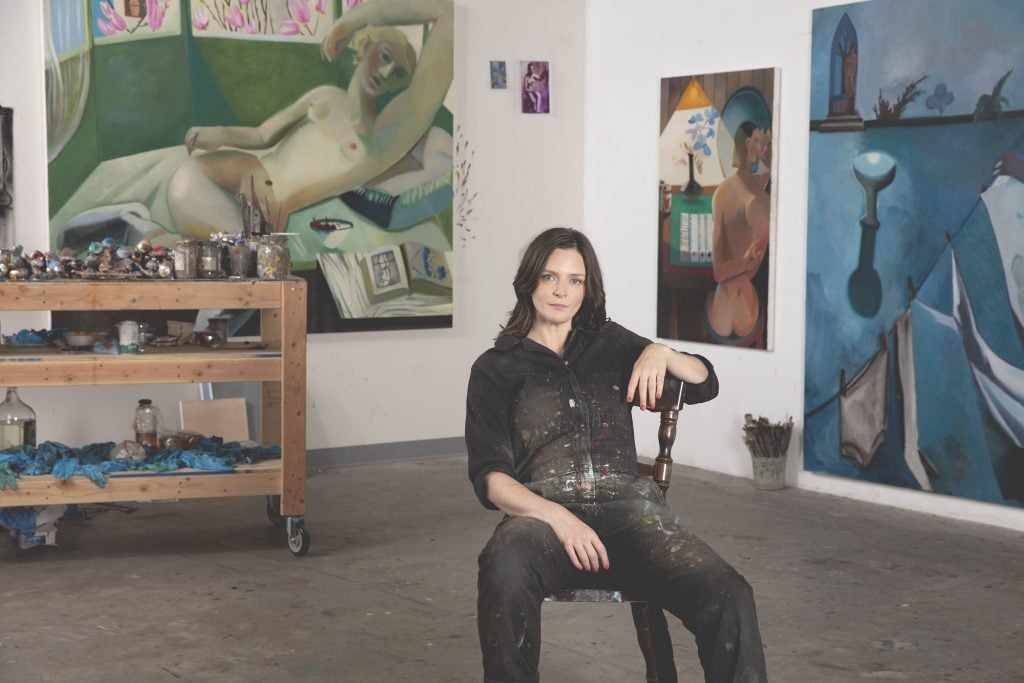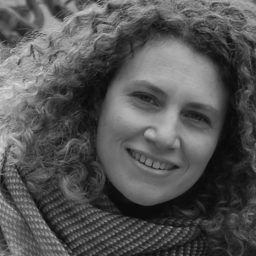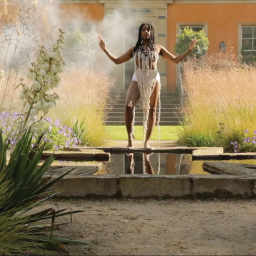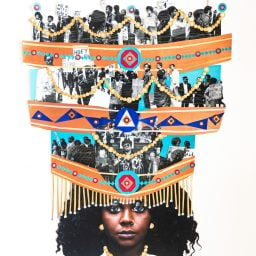“I have very little hesitation in the studio,” American artist Danielle Orchard said. “I just jump in with both feet.”
Something similar could be said of the way people are responding to the Brooklyn-based artist’s vivid, figurative paintings, which present a contemporary twist on depictions of women throughout art history. Reception of the work has been so enthusiastic that it now takes considerable patience (and quite a few connections) to get a hold of one of Orchard’s paintings, particularly since the artist joined global gallery Perrotin in 2021.
“There’s a waitlist for her work, and it’s growing by the day,” said Perrotin’s New York director Ariel Kliegerman. The artist’s current show at Perrotin Paris, “Page Turner” (through October 8), sold out. She has another one coming up in spring 2023 at Perrotin New York—a rare one-two punch, considering most artists take a few years in between shows. “We’ve already made a few promises to collectors and museums who weren’t able to get access this time,” explained Kliegerman.
Orchard takes a variety of influences—from Analytical Cubism to Renaissance painting, Balthus to Matisse to Caravaggio—and applies them to scenes one might be more accustomed to finding in the slow, quiet build-up of a Hitchcock film. In her paintings, women are seen going about their daily lives, painting their nails, washing thongs in the sink. A slice of pizza drapes over a thigh; they grab at sagging, twisted tights. They masturbate, draw, and seem to know we’re watching.
Orchard has “a very real and unadulterated, uncensored way of looking at art history,” Kliegerman said. She takes “certain taboos and puts her own gaze into them.”
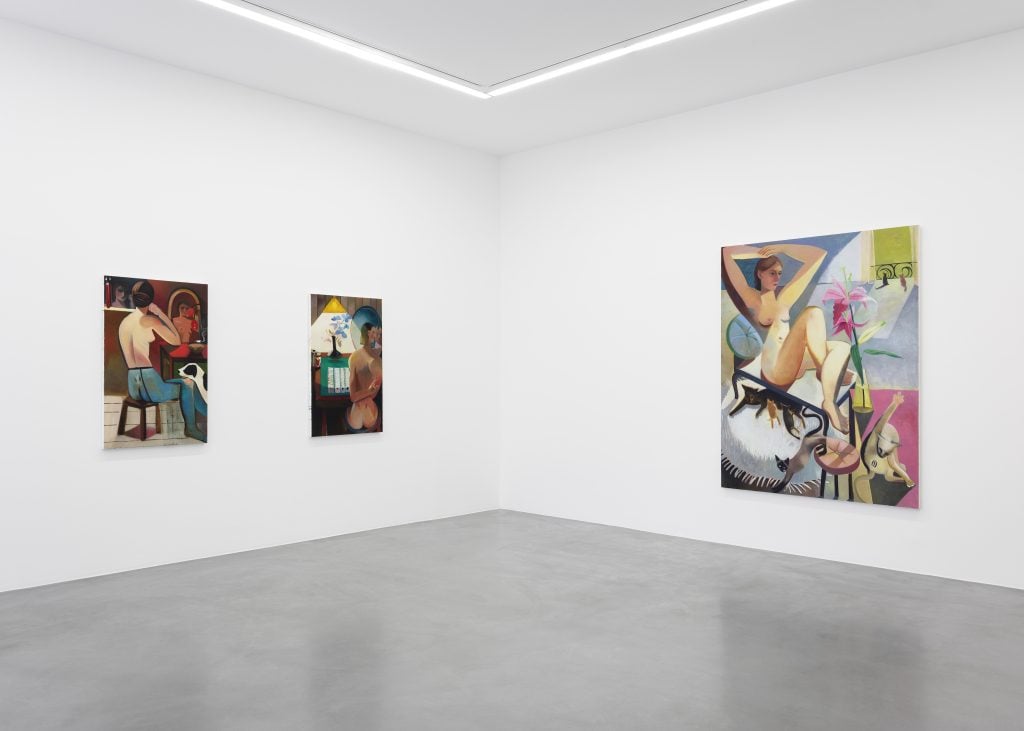
Installation view of Danielle Orchard, “Page Turner,” at Perrotin Paris, 2022. Photo: Claire Dorn. Courtesy of the artist and Perrotin.
Perrotin came to Orchard’s work on the recommendation of both collectors and artists who work with the gallery. (GaHee Park and Genesis Belanger, whose co-curated group show for Perrotin is in the same building as Orchard’s Paris presentation, consider her a friend.)
The crushing demand has put a fire under the secondary market for her work. In November 2021, she donated a painting of a woman smoking in the bathtub to a benefit auction for the Public Art Fund. It carried a high estimate of $8,000—and ended up selling for an eye-popping $287,500.
Since then, 12 of her paintings have hit the auction block, and nearly all have exceeded expectations. In June, the 2020 canvas Night Out fetched $175,565 at Phillips Hong Kong, more than triple the $50,000 high estimate. This marks considerable a break from her primary market, where large works are in the $80,000 range, with smaller to medium pieces priced around $30,000.
“As her gallery, it’s our responsibility to protect her primary [market], to ensure that her work gets into public collections, foundations,” Kliegerman said. A few of Orchard’s paintings are set to appear in upcoming group museum shows in Asia and South America, she noted.
While Orchard (b. 1985) is still young, she has had time to develop her style. Before joining Perrotin, she spent years exhibiting with smaller outfits, including Jack Hanley Gallery, V1 Gallery, and Half Gallery. That track record “gives you a bit of insurance against wild speculation,” said Bill Powers of Half Gallery. “In Danielle’s case, it was a bit of a slower build, which gives you a better shot at longevity, market-wise.”
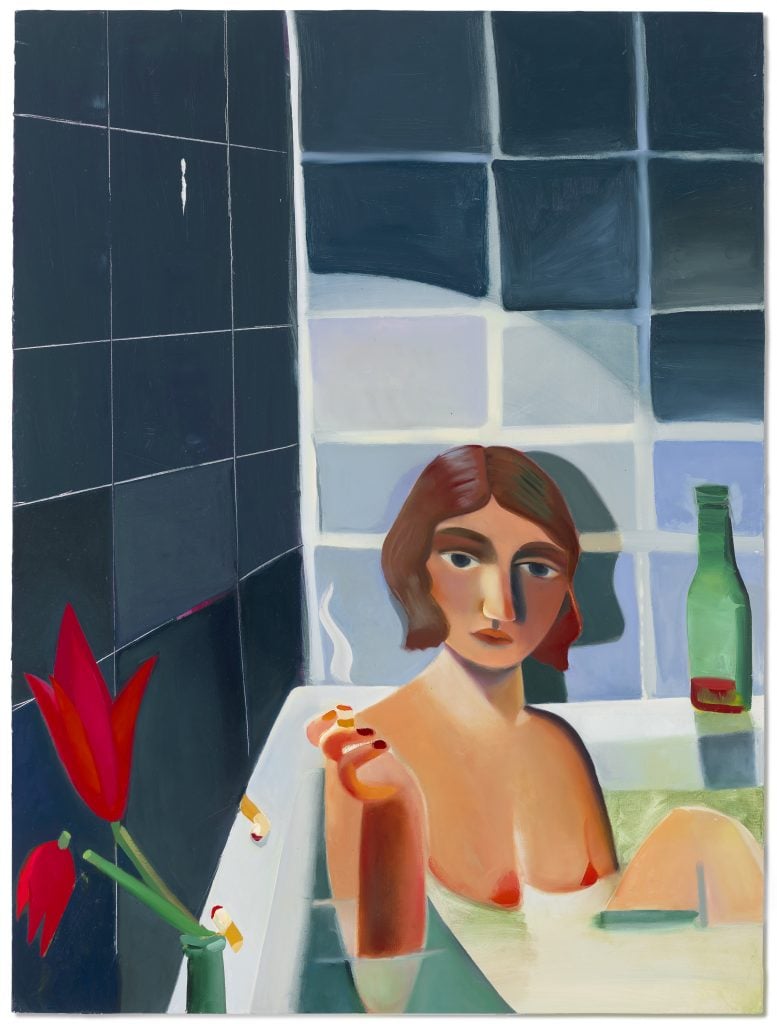
Danielle Orchard, Two Bathers (2021). Image courtesy Christie’s Images Ltd. 2021.
Art was always part of Orchard’s life. Raised in a large family in Indiana, she grew up drawing and felt encouraged by relatives and teachers. “I kept sketchbooks through high school, and afterward went on to study painting at Indiana University, the only college I applied to,” she said. Following graduation, she was accepted to several MFA programs, but ultimately chose Hunter College because it was “cheapest and located in New York City, where I felt I needed to be.”
Those early years drawing in quiet shape her studio practice now. “Drawing provided sanctuary and privacy,” she said. “That’s probably why I’ve never thought to hire an assistant—I don’t really want anyone else in here.”
Orchard’s mastery of theatrical lighting and color knit form and subject together—her compositions draw you in with a combination of beauty and unsettling alienation. Though her angular, pared-down subjects might suggest a long, deliberate process, Orchard says she doesn’t plan much of the work ahead.
“I’m not someone to sit and contemplate. I really have to get ideas from the process,” she said. “A game I have is to choose a color I think is particularly unappealing, that is not in my wheelhouse, and I’ll try to get it to work for me.” Manipulating pigment “so it doesn’t feel like it’s an applied color, but is really of the form, but then still allowing for some strangeness” is “one of the puzzles that keeps me coming back to painting.”
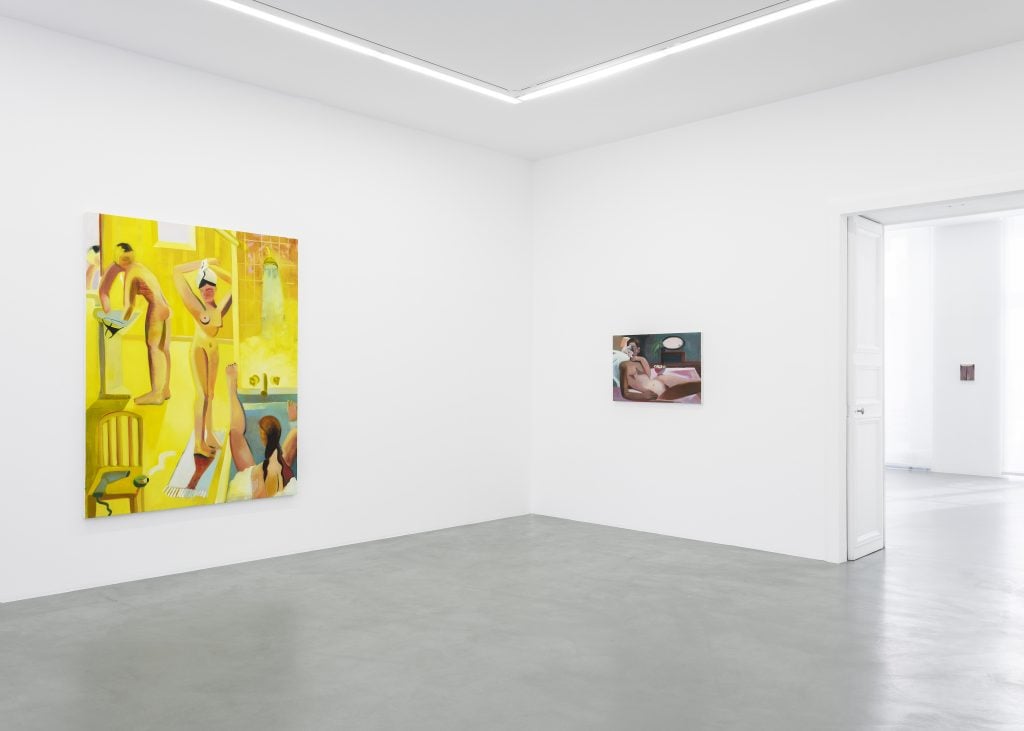
Installation view of Danielle Orchard, “Page Turner,” at Perrotin Paris, 2022. Photo: Claire Dorn. Courtesy of the artist and Perrotin.
Working on the floor helps. It allows the pigment to “move around very freely… I’m just responding to the geometry that emerges naturally, and then pushing it, and composing as I go.”
Just as her use of color and light can feel theatrical—a “back-and-forth between the artificial and the natural,” as Orchard put it—her subjects echo similar tension. They seem to be posing on a stage. Nude or partly undressed women in everyday scenes appear self-conscious and statuesque, aware of us viewers and the artist. These images mine “the narrative ambivalence of a female subject painted by male masters with questionable ethics,” Orchard said.
It’s a quandary that struck her while posing as a figure model in school. “It was an interesting dynamic between guessing what others were seeing and imagining how I might draw and construct the image, and also physically holding the pose at the same time. It created this interplay between physical habitation and imagined viewership that is still at the center of my work,” she said.
Art history is Orchard’s backboard, and she is not afraid to bend it. “Having this jumping off point that’s often pulled from modern masters … I’m able to ground the viewer in this familiar space where they might know what to expect narratively, but then push it into a direction that is more contemporary or specific to my lived experience—to the woman painter living in New York in 2020,” she said.
And why not? As Orchard points out, “You’re moving across centuries all the time when you’re making a painting anyway. To pull freely from any point is one of the more fascinating things we’re able to do.”
